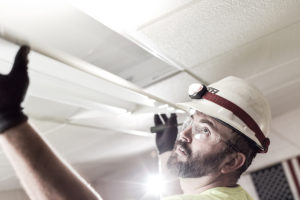01.12.2021
Implementing a Successful Lighting Project
 Implementing a lighting project today doesn’t have the same considerations as the lighting retrofits of 2012 or earlier. In those days, you could simply evaluate options like lower wattage lamps, eliminating fixtures or adding occupancy sensors. Today, in addition to these options, you must compare multiple LED lamp replacement solutions to volumetric retrofits or new fixtures, and that doesn’t begin to address the variety of control packages. Add to that the selection of your designer, manufacturer, budget, etc., and it can seem overwhelming.
Implementing a lighting project today doesn’t have the same considerations as the lighting retrofits of 2012 or earlier. In those days, you could simply evaluate options like lower wattage lamps, eliminating fixtures or adding occupancy sensors. Today, in addition to these options, you must compare multiple LED lamp replacement solutions to volumetric retrofits or new fixtures, and that doesn’t begin to address the variety of control packages. Add to that the selection of your designer, manufacturer, budget, etc., and it can seem overwhelming.
At Faith Technologies, we work with many facility teams who are struggling with decision making. There are several steps you can take to guide you through the best approach to lighting design and implementation that will ensure you meet your goals and expectations. The first step in that process is finding a trusted lighting designer.
Today there are more lighting specifiers than ever before, and all are not created equally. You can choose from an architect or engineering firm, an energy service company (ESCO), a turnkey provider or a lighting designer. Each have varying degrees of credentials and experience, and there is not one type that is right for every lighting project.
- Architect and engineering firms are great for projects that involve construction redesign of space.
- ESCOs take a more holistic project approach, specializing in energy-related redesigns that tackle multiple solutions. For example, if you are looking to upgrade your lighting, add a rooftop solar array and install a more efficient boiler system, an ESCO can be a “one-stop shop” that will combine multiple measures into one project, providing lighting solutions that integrate seamlessly with a larger construction or energy-efficiency scope.
- A turnkey provider can complete both design and installation of your lighting system.
- Lighting designer is a fairly broad title, but refers to companies that are designing the system but not installing with their own installation crew. They create the scope of work and either allow the end user to select the installing contractor or hire a third-party installation crew.
The scope of your project will help you determine whether an architect or ESCO is necessary based on your goals. The following are considerations when choosing between a turnkey provider and lighting designer.
- Experience: How long have they been in the lighting retrofit industry? We are seeing an explosion of companies pop up over the last few years that saw the market shift and are taking advantage of the fact that almost anything LED will save energy over traditional lighting systems.
- References: Ask for a list of references and information about past projects that implemented a scope of work similar to what you are trying to accomplish, as well as others that may not be related in scope. It is important that your designer has experience in many types of LED projects so they can address the variety of fixtures you have in your facility. If you are considering a network lighting solution, for example, do you want to be their first project experimenting with the product? When issues arise, you need to trust they can address them quickly and effectively with minimal downtime to your facility and staff. Reach out to their references and ask how easy they were to work with and how they managed the project.
- Partnerships: Some companies will only quote third-tier manufacturers because they know they are sold at a lower price point, which means a quicker return on investment (ROI) and higher likelihood of a sale. Beware! The adage “You get what you pay for” certainly applies to lighting products. Many of the manufacturers that were created in the last few years are not actually manufacturing their own product. They buy a no-name panel, add a private label and call it their own. They tout a “10-year warranty” and vanish around the time you need support. At Faith Technologies, we only partner with first-tier manufacturers that are leaders in the industry and have a track record of working through warranty issues and making things right.
- Financials: The company’s financial stability is important because your designer is the last line of defense when a warranty issue arises. When considering your design firm, do they have the financial standing to cover anything the manufacturer does not?
- Installation: Most facilities find it important to evaluate the installation crew as well. If your design team and install crew are in the same company, it will simplify the process, and will enable one line of communication between you, the designer and the installation crew.
- Safety: It is important to ensure the safety records of your chosen designer. Ask questions of those who will be in your facility when nobody else is around or who will be working around your staff. How do they approach safety? The answers to these questions can have a direct impact on the safety and wellbeing of your staff.
Implementing a lighting project isn’t something you have to start from scratch. At Faith Technologies, we have nearly 30 years of experience in the lighting industry. If you’re considering a big or small lighting project or would like information about where to start, please feel free to reach out for more information.
If you enjoyed this blog article, please subscribe to stay up to date on the latest industry news from our experts at Faith Technologies.




